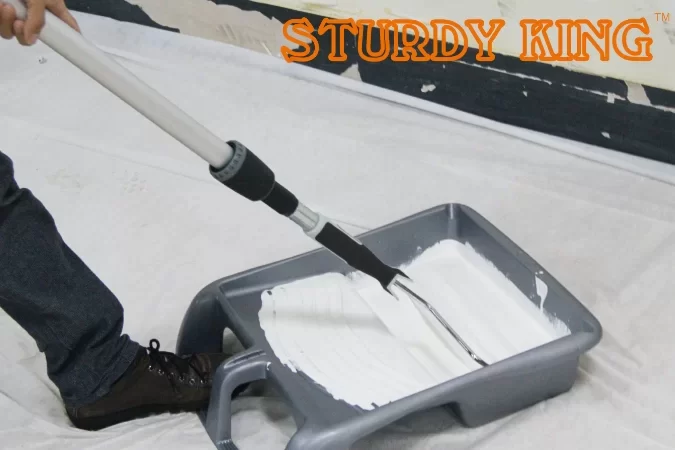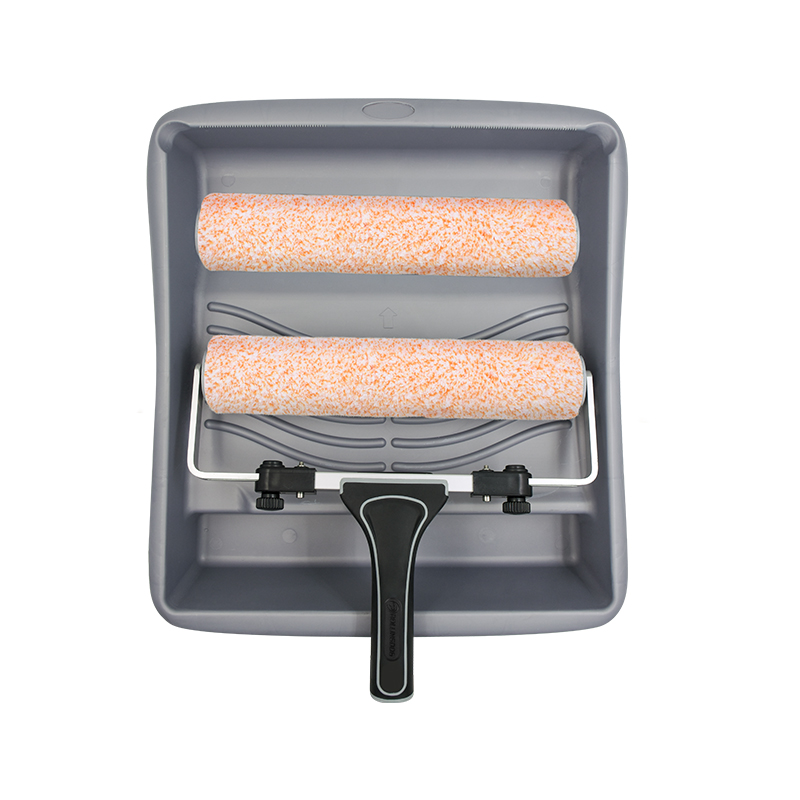Looking for a reliable paint tray supplier for your wholesale or private label business? At Rollingdog, we specialize in manufacturing high-quality paint trays trusted by professionals worldwide. Whether you’re sourcing paint roller trays for contractors or stocking durable plastic paint trays for retail, this guide will help you make informed decisions that drive sales and brand loyalty.

1. What Is a Paint Tray and Why Does It Matter in Professional Painting?
1.1 The Role of a Paint Tray in Painting Projects
A paint tray is more than just a container for holding paint — it is a tool that directly impacts painting efficiency, finish quality, and material control. Designed to work seamlessly with paint rollers, a paint tray allows painters to evenly distribute paint across the roller surface, preventing drips and reducing paint waste. It’s an essential item in every professional toolkit, whether the project involves large commercial walls or fine-detail interior work.
Professional painters often use paint roller trays with ridged wells that help remove excess paint and control the amount transferred to the surface. This ensures even application and reduces the need for corrections. Whether you’re working with latex, oil-based, or specialty coatings, a properly matched paint tray can save time and effort while improving the overall finish.
Especially for B2B buyers and international sourcing agents, offering the right type of paint tray for roller use is a valuable addition to your catalog. It shows that your product line supports professionals who demand performance, not just affordability.
1.2 Why Professionals Prefer High-Quality Paint Trays
Professional painters know that low-quality paint trays can crack, warp, or leak, disrupting workflow and leading to additional clean-up time or material loss. Durability is crucial, especially for repetitive or large-scale jobs. This is why many professionals turn to plastic paint trays or metal alternatives that offer structural integrity and chemical resistance.
Moreover, advanced features such as anti-slip bases, liner compatibility, and ergonomic designs make handy paint trays more desirable in demanding environments. For example, a paint tray for ladder use typically comes with hooks or attachments to stabilize the tray mid-air — a small innovation with huge benefits on vertical projects.
When stocking for wholesale, it’s wise to prioritize trays that cater to professional preferences. Products that combine utility, durability, and safety features are more likely to gain traction in competitive markets.
2. Do Professional Painters Use Paint Trays?
2.1 When and Why Professionals Use Paint Trays
Yes, professional painters almost always rely on paint trays during rolling applications, especially for interior and exterior wall jobs. While larger-scale operations may use paint buckets with roller grids, the paint tray remains irreplaceable for medium-sized projects, tight spaces, or precision work.
In many cases, professionals use different paint tray sizes depending on the surface area and type of coating. For instance, a small paint roller and tray combo is ideal for trim, cabinets, or narrow walls, whereas a standard paint pan accommodates larger rollers for broad strokes on drywall or siding.
The controlled paint reservoir also minimizes spills and saves time during application. For contractors who juggle multiple jobs in a week, that time adds up quickly, making trays an indispensable asset.
2.2 Comparing Trays with Other Paint Holding Tools
While buckets and roller grids are suitable for industrial-scale work, they lack the precision and mobility of a disposable paint tray or stackable plastic trays. Paint trays are lighter, easier to clean (especially with liners), and offer better control in tight or overhead areas.
Also, paint tray for ladder use is a crucial niche that only trays can fill. With special locking designs and ladder attachments—like those offered by RollingDog Tools’ professional-grade trays—they make working at height safer and more efficient, a necessity in commercial and renovation projects.
In summary, professionals use paint trays for a reason: they’re practical, portable, and designed for accuracy. As a wholesale supplier, stocking quality trays tailored for pro use isn’t just smart — it’s essential.
3. Where to Buy High-Quality Paint Trays in Bulk?
3.1 Best Global Sourcing Channels for Paint Trays
When looking to source a paint tray in bulk, choosing the right platform can significantly impact your product quality, margins, and delivery times. International B2B platforms such as Alibaba, Global Sources, and Made-in-China offer access to hundreds of paint tray manufacturers, especially those based in China — the world’s leading manufacturing hub for painting tools.
These platforms allow you to filter suppliers by certification, production capacity, and past transaction records. However, while browsing online is a good starting point, attending trade shows like the Canton Fair or the China International Hardware Show provides a better opportunity to inspect paint tray samples in person, discuss custom designs, and evaluate factory quality.
Another option for large importers is working with a sourcing agent or supplier management firm. These professionals can help identify reputable paint tray factories, inspect goods before shipment, and manage communication barriers.
For those seeking eco-friendly options, some manufacturers now specialize in disposable paint trays made from recycled plastics or biodegradable materials, catering to growing demand in Western markets.
Paint roller tray options with anti-drip designs and compatibility with liners are particularly popular in the European and North American wholesale markets, so it’s critical to ensure your supplier can meet these technical expectations. Consider requesting SGS or ISO certificates as part of your due diligence.
Ultimately, bulk buying from verified paint tray suppliers not only lowers unit costs but also strengthens your wholesale supply chain with better consistency and speed.
3.2 Key Considerations When Choosing a Bulk Supplier
Not all paint tray suppliers are created equal. When selecting a partner for your wholesale business, several critical factors come into play — beyond just price. First, assess the supplier’s manufacturing capabilities. Can they produce high-volume orders on time? Do they offer OEM/ODM services for custom branding?
Check for quality certifications such as ISO9001 or BSCI compliance. These are strong indicators of standardized processes and ethical labor practices. Ask about the types of materials used. For example, plastic paint trays made of virgin polypropylene are more durable and lightweight compared to cheaper recycled mixes, which may crack under pressure.
Another tip: always request samples of the paint tray for roller you intend to sell. This allows you to evaluate paint holding capacity, surface texture, and grip ergonomics. Many importers overlook this and end up with products that fail quality expectations — a costly mistake in the B2B space.
Logistics is another vital point. Consider whether the supplier has experience shipping to your target market and understands local packaging requirements. Consolidated shipping options can reduce costs, especially for bulky items like trays.
Lastly, review testimonials or client case studies. A supplier that has previously served large brands or international wholesalers is more likely to deliver consistent quality. Choosing wisely at this stage ensures your paint tray offering stands out in a crowded market.

4. What Are the Most Durable Paint Trays for Professional Use?
4.1 Comparing Paint Tray Materials: Plastic, Metal, and Recycled
When durability is the priority, understanding the materials used in paint tray manufacturing is essential. The most common materials are high-density plastic (polypropylene), metal (typically stainless steel or aluminum), and recycled or composite materials. Each comes with its strengths and limitations.
Plastic paint trays dominate the market due to their lightweight nature, low cost, and ease of cleaning. High-quality trays made of virgin polypropylene or polyethylene can last through multiple uses and offer high chemical resistance. These are ideal for professional painters who need performance and portability.
Metal paint trays, while more expensive, are the go-to choice for heavy-duty industrial projects. They withstand rugged job site conditions and high paint volumes without bending or warping. They’re also ideal for use with paint tray for ladder setups, where strength and balance are crucial.
In recent years, many suppliers have introduced handy paint trays made from recycled or biodegradable materials to serve eco-conscious markets. While these options are gaining traction, they may lack the long-term durability needed for intensive use.
When selecting wholesale paint trays, always match material to your buyer’s application. Contractors working with solvents or enamels will prefer chemical-resistant options, while budget-conscious buyers may opt for reusable plastic trays with compatible liners.
4.2 Features That Improve Longevity and Performance
A durable paint tray isn’t just about the material — design features also play a big role. Look for trays with ribbed rolling surfaces, which help evenly distribute paint on the roller and reduce wastage. Reinforced corners and thick sidewalls prevent cracking during transport or onsite use.
An anti-slip base is another essential feature, especially for professionals working on ladders or uneven terrain. According to the American Coatings Association, slip-resistant tools are critical for reducing worksite accidents. Some paint roller trays come with integrated notches or hooks to securely attach to ladders — a small but game-changing innovation that improves safety and workflow.
Consider trays with built-in liners or compatibility with disposable liners. This not only extends the life of the paint tray, but also improves efficiency between jobs, making it easier for painting contractors to switch colors without cross-contamination.
In high-demand markets like the U.S. and Europe, contractors are also looking for ergonomic handles, stackable storage designs, and trays that fit small paint roller and tray sets — particularly for detailed work in residential and commercial interiors.
To stay competitive as a wholesaler, ensure your paint tray offering aligns with these trends and includes models designed for durability, ease of use, and compatibility with professional workflows.
5. How to Choose the Best Paint Tray for Your Product Catalog
5.1 Identifying Buyer Needs in Different Markets
Curating the right mix of paint tray models for your catalog starts with a deep understanding of your target buyer segments. Are you serving professional contractors, DIY enthusiasts, or industrial customers? Each group prioritizes different tray features and price points.
For professional painters, durability and functionality take precedence. They often prefer trays with high paint capacity, ribbed surfaces, and anti-slip bases. Pairing these with a paint roller tray that includes ladder hooks or ergonomic grips enhances job site safety and efficiency — a major selling point in competitive B2B deals.
DIY users, on the other hand, value convenience and cost. Compact, handy paint tray designs that fit standard rollers and include pour spouts are especially popular for this segment. Offering small paint roller and tray kits is also a great way to drive volume sales in the home improvement retail channel.
In regions with rising sustainability awareness, eco-friendly options like disposable paint trays made from biodegradable or recycled materials are gaining traction. If you’re supplying retailers in Europe or North America, these green alternatives help position your brand ahead of regulatory trends.
When building your product catalog, diversification is key. Stock a balanced mix of paint tray sizes (standard, mini, jumbo), materials (plastic, metal, recycled), and functions (with liners, with pour lips, ladder-compatible). Doing so ensures broader appeal and helps meet procurement needs from multiple buyer profiles.
Also, don’t overlook packaging and bundling. Offering trays in sets or kits, such as a paint tray for roller paired with matching brushes, increases perceived value and simplifies inventory management for wholesalers.
Ultimately, your catalog should reflect both current buyer preferences and emerging trends — ensuring your paint tray portfolio stands out from generic competitors.
5.2 Customization Options for Retailers and Brands
Customization is one of the most effective ways to elevate your paint tray offerings and attract retail partnerships. Branding your trays with unique colors, logos, or functional enhancements not only boosts shelf appeal but also creates loyalty among B2B clients.
Many leading suppliers in China now offer OEM/ODM services for plastic paint trays, allowing you to choose from a variety of molds, materials, and surface textures. Whether you need a matte finish for a premium look or a glossy one for easier cleaning, these small tweaks can make a big impact on perceived value.
Functional upgrades are equally valuable. Retailers often request paint pans with integrated liners or splash guards to reduce mess and enhance user experience. Trays with extra-deep wells, textured grids, and ergonomic side grips are also hot-selling features that can be added at minimal cost during mass production.
For clients targeting contractors, offering a paint tray for ladder setup with hook compatibility can differentiate your product from standard models. This adds a professional touch that resonates in trade-focused markets.
Color-coded trays — for example, blue for oil-based paint and red for latex — are another customization that improves workflow efficiency on job sites. These are easy to manufacture but demonstrate thoughtful design and functionality.
MOQ (minimum order quantity) for custom paint tray production is often flexible if you’re working with established manufacturers. Be sure to clarify packaging options as well — printed boxes, shrink-wrap, or display-ready kits all affect product presentation and shipping logistics.
Incorporating customization into your B2B catalog helps create a tailored solution for each client, increasing order volume and reducing competition from generic tray resellers. Whether for retail chains or independent distributors, a customized paint tray solution can become a long-term best-seller in your portfolio.
6. How to Evaluate a Reliable Paint Tray Manufacturer in China
6.1 What Certifications and Capabilities to Look For
When sourcing paint tray products from China, identifying a reliable manufacturer is essential for building a resilient supply chain. Start by checking if the factory holds internationally recognized certifications like ISO 9001 for quality management and BSCI for ethical labor compliance. These credentials reflect the manufacturer’s long-term commitment to quality and corporate responsibility.
Equally important is production capability. Ask potential suppliers for data on their monthly paint tray output, material sourcing, and internal quality control systems. Can they produce thousands of paint roller trays with consistent thickness, uniform dimensions, and smooth finishes? This consistency is critical for retail success and B2B fulfillment.
Take a tour of the facility—physically or virtually—to verify their in-house processes. Leading paint tray manufacturers will have injection molding machinery, raw material storage, and dedicated QA departments. Look for signs of automation and streamlined production lines, which suggest efficiency and scalability.
You should also request product samples and test them in real-world conditions. Compare paint pans across different batches to check for color uniformity, sturdiness, and chemical resistance. A truly professional manufacturer will welcome these tests and adjust specifications to meet your quality standards.
Finally, consider their export history. Have they worked with major brands or international wholesalers before? A strong client portfolio indicates that the manufacturer understands global compliance, logistics coordination, and customer service — crucial traits for successful B2B relationships.
Choosing the right paint tray supplier is not just about price; it’s about reliability, compliance, and capability to deliver consistently high-quality goods.
6.2 Questions to Ask Before Signing a Deal
Before entering into a contract with any paint tray supplier, it’s essential to conduct due diligence with targeted questions. These help ensure you’re partnering with a manufacturer who aligns with your business goals and product standards.
Start by asking: What are your MOQ requirements for custom designs? Understanding this early helps you plan your catalog strategy, especially if you’re aiming to launch a line of branded or plastic paint tray products. If the MOQ is too high, it might limit your agility in testing new SKUs.
Next, inquire about lead time. A reliable supplier should offer clear timelines for mold preparation, sampling, production, and delivery. Delays in paint tray production can cause downstream issues in retail launches or project fulfillment, so accurate scheduling is key.
You should also ask about their material sourcing — particularly if you’re ordering disposable paint trays or eco-friendly options. What plastics or composites do they use? Are they REACH or RoHS compliant? This is especially critical if you’re distributing in the EU or North America.
Discuss their QA process. Do they conduct on-site inspections, third-party audits, or provide detailed QC reports? The more transparent the factory is with its quality systems, the more confident you can be in bulk procurement.
Additionally, clarify shipping arrangements. Does the supplier work with freight forwarders experienced in exporting paint tray items? Do they offer FOB, CIF, or DDP terms? Smooth logistics are just as important as manufacturing when dealing in international trade.
By asking these questions, you not only protect your investment but also establish a foundation for long-term cooperation with a high-quality paint tray manufacturer in China.

7. What Materials Are Best for Wholesale Paint Trays: Plastic, Metal, or Recycled?
7.1 Comparing Durability and Cost Efficiency
When selecting materials for wholesale paint tray production, understanding the trade-off between durability and cost is essential. The most common options on the market are plastic, metal, and recycled composite trays, each with distinct advantages depending on the use case and buyer preference.
Plastic paint trays are the most widely used, especially for general-purpose and DIY applications. They’re lightweight, cost-effective, and easy to stack for bulk shipping. However, their long-term durability can vary based on the type of plastic used. For professional use, thicker plastics with reinforced rims can significantly increase longevity and value.
Metal trays, usually made from galvanized steel or aluminum, are preferred in heavy-duty industrial applications. These paint trays offer superior strength, resistance to warping, and high heat tolerance — ideal for repeated use with strong solvents. However, they are more expensive and heavier, which may increase shipping costs.
Recycled materials are gaining popularity, especially among eco-conscious retailers. Trays made from recycled plastics or blended resins are cost-competitive with virgin plastic options while supporting sustainability goals. These disposable paint trays often appeal to buyers in markets like Europe or Canada, where environmental regulations are more stringent.
For bulk buyers, it’s crucial to align material selection with end-user expectations. Contractors may prefer durable metal or premium plastic options, while retail chains might lean toward small paint roller and tray sets using affordable and recyclable materials.
Ultimately, a versatile catalog that includes various paint tray materials allows you to serve multiple market segments efficiently and cost-effectively.
7.2 Environmental Considerations and Buyer Preferences
Today’s global buyers are increasingly prioritizing environmental responsibility when choosing suppliers, and the paint tray market is no exception. As sustainability becomes a key factor in procurement decisions, offering eco-friendly tray options can set your business apart.
Many retailers and distributors are actively seeking paint trays that use recycled materials or are fully recyclable. This trend is especially strong in regions like Europe, Australia, and parts of North America. Offering handy paint tray models made from post-consumer plastic or biodegradable components demonstrates that your business is aligned with modern values.
Another approach is to reduce waste by offering reusable trays or paint tray for roller kits with washable liners. This not only appeals to environmentally conscious consumers but also reduces long-term costs for professional users. Bundling these features into your catalog increases perceived value while contributing to a greener supply chain.
Some buyers now request certifications such as FSC (for packaging), ISO 14001 (for environmental management), or proof of sustainable sourcing. Partnering with manufacturers who can provide these guarantees is essential when targeting environmentally sensitive markets.
Although not all clients will make purchasing decisions solely based on environmental credentials, having a line of green paint tray options is increasingly seen as a minimum requirement — not just a bonus. This is especially true when bidding for contracts with government or institutional clients who have strict sustainability policies.
Offering a diverse range of paint trays that consider both performance and eco-impact ensures long-term market adaptability and stronger B2B relationships.
Choosing the right paint tray supplier can impact your margins, customer satisfaction, and product longevity. Rollingdog offers the expertise, quality, and customization options you need to succeed. Contact us today to learn how we can support your bulk orders with premium paint tray for roller solutions and personalized service that sets you apart.


